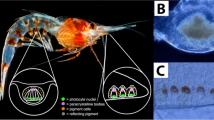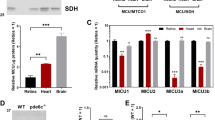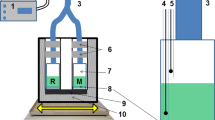Abstract
FOR a wide variety of photoreceptor cells, it has been shown that light alters the conductance of the cell membrane, giving rise to the voltage response of the cell1–4. It is generally accepted that the primary event in the photo-excitation process is a light-induced isomerisation of the photopigment chromophore. The mechanisms linking this isomerisation to the conductance change remain unknown. It has been suggested recently that the transduction process may depend on oxidative metabolism. Intracellular recordings from photoreceptors of the honeybee (A pis)5, horseshoe crab (Limulus)5 and barnacle (Balanus)—observed recently by one of the authors (A.M.) in collaboration with R. Lantz—have shown that the light-induced conductance increase during illumination can be reversibly blocked by anoxia. Neither the site nor the mechanism of the action of anoxia on the transduction process is known. The light-induced spectral transitions of the photopigments are known, however, to take place under a variety of conditions including anoxia6–10.
This is a preview of subscription content, access via your institution
Access options
Subscribe to this journal
Receive 51 print issues and online access
$199.00 per year
only $3.90 per issue
Buy this article
- Purchase on Springer Link
- Instant access to full article PDF
Prices may be subject to local taxes which are calculated during checkout
Similar content being viewed by others
References
Toyoda, J., Nosaki, H., and Tomita, T., Vision Res., 9, 453–463 (1969).
Fuortes, M. G. F., J. Physiol., Lond., 148, 14–28 (1959).
Millecchia, R., and Mauro, A., J. gen. Physiol., 54, 331–351 (1969).
Brown, H. M., Hagiwara, S., Koike, H., and Meech, R. W., J. Physiol., Lond., 208, 385–413 (1970).
Baumann, F., and Mauro, A., Nature new Biol., 244, 146–148 (1973).
Hillman, P., Dodge, F. A., Hochstein, S., Knight, B. W., and Minke, B., J. gen. Physiol., 62, 77–86 (1973).
Smith, T. B., and Brown, J. E., Nature, 212, 1217–1219 (1966).
Abrahamson, E. W., and Ostroy, S. E., Progr. Biophys., 17, 179–215 (1967).
Cone, R. A., and Pak, W. L., in Handbook of Sensory Physiology, 1 (edit. by Loewenstein, W. R.), 345–365 (Springer-Verlag, New York, 1971).
Hagins, W. A., and McGaughy, R. E., Science, 157, 813–816 (1967).
Hochstein, S., Minke, B., and Hillman, P., J. gen. Physiol., 62, 105–128 (1973).
Nolte, J., Brown, J. E., and Smith, T. G., Science, 162, 677–679 (1968).
Muijser, H., Leutscher-Hazelhoff, J. T., Stavanga, D. G., and Kuiper, J. W., Nature, 254, 520–522 (1975).
Cosens, D., and Briscoe, D., J. Insect Physiol., 18, 627–632 (1972).
Ostroy, S. E., Wilson, M., and Pak, W. L., Biochem. biophys. Res. Commun., 59, 960–966 (1974).
Minke, B., Wu, C.-F., and Pak, W. L., J. comp. Physiol., 98, 345–355 (1975).
Brown, H. M., and Cornwall, M. C., J. Physiol., Lond., 248, 579–593 (1975).
Minke, B., Wu, C.-F., and Pak, W. L., Nature, 258, 84–87 (1975).
Wu, C.-F., and Pak, W. L., J. gen. Physiol., 66, 149–168 (1975).
Pak, W. L., Grossfield, J., and White, N. V., Nature, 222, 351–354 (1969).
Brown, H. M., Meech, R. W., and Thomas, R. C., Biophys. J., 16, no. 2, part 2, 33a (1976).
Goldsmith, T. H., and Bernard, G. D., in Physiology of Insecta, 2 (edit. by Rockstein, M), 165–272 (Academic, New York, 1974).
Author information
Authors and Affiliations
Rights and permissions
About this article
Cite this article
WONG, F., MAURO, A., WU, CF. et al. Persistence of prolonged light-induced conductance change in arthropod photoreceptors on recovery from anoxia. Nature 264, 661–664 (1976). https://doi.org/10.1038/264661a0
Received:
Accepted:
Issue Date:
DOI: https://doi.org/10.1038/264661a0
This article is cited by
-
Light dependence of oxidative metabolism in fly compound eyes studied in vivo by microspectrofluorometry
Naturwissenschaften (1983)
-
Suppression of noise in a photoreceptor by oxidative metabolism
Journal of Comparative Physiology ? A (1981)
-
Cycloheximide suppresses a behavioral modification in Drosophila
Naturwissenschaften (1979)
-
On the implications of bistability of visual pigment systems
Biophysics of Structure and Mechanism (1979)
-
Transduction in photoreceptors with bistable pigments: Intermediate processes
Biophysics of Structure and Mechanism (1979)
Comments
By submitting a comment you agree to abide by our Terms and Community Guidelines. If you find something abusive or that does not comply with our terms or guidelines please flag it as inappropriate.



